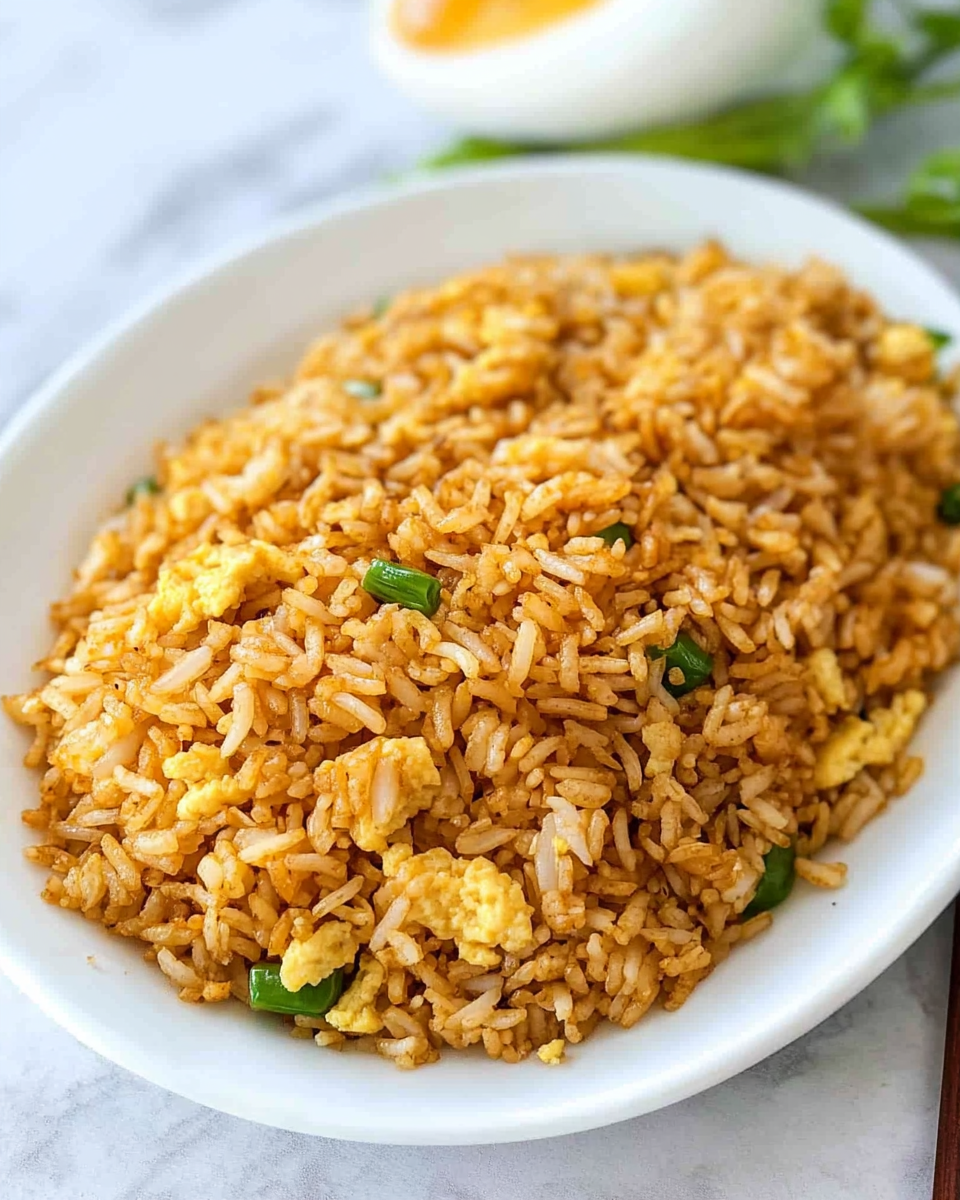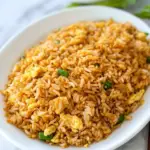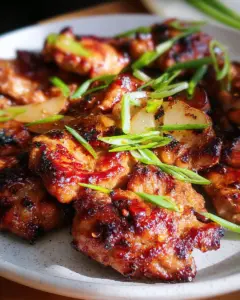Egg fried rice is a cornerstone of Chinese cuisine, celebrated for its simplicity, versatility, and ability to turn basic ingredients into a satisfying meal. With just day-old rice, eggs, and a few pantry staples, you can recreate the takeout-style magic at home in under 10 minutes. The dish’s appeal lies in its crispy-yet-tender texture, achieved by frying cold rice over high heat, and the umami depth from soy sauce and sesame oil. Whether you’re cooking for one, repurposing leftovers, or craving a quick side, this recipe delivers flavor without fuss.

Preparation Phase & Essential Tools
Tools and Equipment
- Wok or large non-stick pan: A wok’s high sides and even heat distribution are ideal for stir-frying, but a skillet works too.
- Spatula or wooden spoon: Essential for breaking up rice clumps and tossing ingredients.
- Mixing bowls: For beating eggs and prepping garnishes.
- Measuring spoons: Precision ensures balanced seasoning—no overpowering soy sauce or sesame oil.
Why These Tools Matter
- A carbon steel wok develops wok hei (that smoky takeout flavor) when heated properly.
- Cold, day-old rice has less moisture, preventing mushiness. Fresh rice steams instead of frying.
- Pre-measuring sauces streamlines cooking, as stir-frying happens quickly.
Preparation Tips
- Rice prep: Spread freshly cooked rice on a tray to cool faster, or use leftovers.
- Egg technique: Lightly beat eggs with a pinch of salt for fluffier curds.
- Mise en place: Chop green onions and measure sauces before heating the pan.
Ingredients List
- 2 cups cooked jasmine rice: Cold and day-old is non-negotiable for the best texture.
- 4 large eggs: Beaten until just blended for tender scrambles.
- 2 tablespoons vegetable oil: A neutral oil with a high smoke point.
- 1 green onion: Finely chopped for a fresh, sharp finish.
- 2.5 tablespoons regular soy sauce: Not dark soy sauce, which is thicker and sweeter.
- ½ tablespoon sesame oil: Adds nutty aroma; drizzle at the end to preserve flavor.
Optional Add-Ins:
- Minced garlic or ginger for depth.
- Frozen peas or diced carrots for color and crunch.
Step-by-Step Instructions
1. Heat the Oil
- Warm 1 tablespoon of vegetable oil in a wok or pan over medium-high heat. For authentic wok hei, let the oil smoke lightly before adding eggs. Skip this step in a regular skillet to avoid burning.
2. Cook the Eggs
- Pour beaten eggs into the pan. Stir immediately with a spatula, scrambling just until set but still slightly runny—they’ll finish cooking with the rice. Transfer to a plate if you prefer larger curds.
3. Fry the Rice
- Add remaining 1 tablespoon oil to the pan, followed by cold rice. Use the spatula to break up clumps, pressing gently to separate grains. Stir-fry for 2 minutes until rice is lightly toasted.
4. Add Aromatics
- Push rice to one side. Add green onions (and optional garlic/ginger) to the empty space, letting them sizzle for 10 seconds before mixing into the rice.
5. Season and Finish
- Drizzle soy sauce and sesame oil around the edges of the pan (not directly onto rice) to intensify their flavors. Toss everything until evenly coated. Fold in cooked eggs.
6. Serve Immediately
- Plate while hot. Garnish with extra green onions or a dash of white pepper for extra warmth.
Pro Tip: For richer flavor, substitute butter for half the oil when cooking eggs.
Egg fried rice is incredibly versatile, working equally well as a quick main dish, a hearty side, or a base for more elaborate meals. Here are some delicious ways to serve it:
- As a Standalone Meal: Top with a fried egg for extra richness, or add protein like diced chicken, shrimp, or tofu for a more filling dish.
- With Classic Takeout Sides: Pair with crispy spring rolls, steamed dumplings, or sweet and sour chicken for a complete restaurant-style experience.
- For Breakfast: Serve alongside Chinese sausage (lap cheong) or a drizzle of chili oil for a savory morning meal.
- With Fresh Vegetables: Balance the dish with a side of stir-fried bok choy or garlic green beans for added crunch and nutrition.
For an extra kick, garnish with:
- Sliced chili peppers or sriracha for heat.
- Toasted sesame seeds or crushed peanuts for texture.
- Fresh cilantro or lime wedges for brightness.
Common Mistakes to Avoid
Even a simple dish like egg fried rice can go wrong if key steps are overlooked. Here’s how to avoid the most frequent pitfalls:
- Using Freshly Cooked Rice – Warm rice turns mushy when stir-fried. Always use cold, day-old rice for the best texture.
- Overcrowding the Pan – Adding too much rice at once lowers the pan’s temperature, leading to steaming instead of frying. Cook in batches if necessary.
- Insufficient Heat – High heat is crucial for that signature wok hei (breath of the wok) flavor. A weak flame results in soggy rice.
- Overloading with Soy Sauce – Too much soy sauce makes the dish overly salty. Start with less—you can always add more.
- Stirring Too Much – Constant stirring prevents the rice from crisping. Let it sit briefly to develop a slight char.
How to Perfect the Recipe
- Toast the Rice Properly: Spread it in an even layer and let it crisp for a minute before stirring.
- Season in Layers: Lightly salt the eggs, then adjust with soy sauce at the end.
- Use the Right Oil: Neutral oils like vegetable or peanut oil work best for high-heat cooking.
8 Best Side Dishes to Pair with Egg Fried Rice
To turn your meal into a feast, consider these complementary dishes:
- Hot and Sour Soup – The tangy, spicy broth contrasts beautifully with the savory rice.
- Kung Pao Chicken – Adds a bold, slightly sweet, and nutty flavor.
- Steamed Dumplings (Jiaozi or Gyoza) – A classic pairing for texture variety.
- Sweet and Sour Pork – The crispy, tangy pork balances the simplicity of fried rice.
- Garlic Green Beans – A quick, garlicky vegetable side for freshness.
- Egg Drop Soup – Light and comforting, making it a great starter.
- Crispy Wontons – Adds crunch and a fun appetizer element.
- Chinese Cucumber Salad – A refreshing, vinegar-based side to cut through richness.
Achieving restaurant-quality egg fried rice requires attention to technique and ingredients. Here are key tips to elevate your dish:
- Rice Texture Matters
- Use long-grain rice like jasmine or basmati—they stay separate and fluffy when fried.
- If you don’t have day-old rice, spread freshly cooked rice on a tray and refrigerate for 1-2 hours to dry it out.
- Maximize Flavor
- For deeper umami, add a splash of oyster sauce or fish sauce along with the soy sauce.
- Cook eggs low and slow at first for creamier curds, then increase heat for the rice.
- Customize with Add-Ins
- Vegetables: Frozen peas, diced carrots, or bell peppers add color and nutrition.
- Protein: Toss in cooked shrimp, chicken, or char siu pork for a heartier meal.
- Spice: Stir in chili garlic sauce or Sichuan peppercorns for heat.
- Wok vs. Skillet
- A carbon steel wok delivers the best wok hei (smoky aroma), but a cast-iron or non-stick skillet works too—just avoid overcrowding.
Storage and Reheating Instructions
Leftover egg fried rice stores well if handled properly:
- Refrigeration
- Cool completely before storing in an airtight container.
- Keeps for 3 days in the fridge.
- Freezing
- Freeze in portion-sized containers for up to 1 month.
- Thaw overnight in the fridge before reheating.
- Reheating for Best Texture
- Stovetop Method: Reheat in a pan with a splash of oil over medium heat, stirring occasionally.
- Microwave Alternative: Sprinkle with 1 tsp water, cover, and heat in 30-second intervals, fluffing between bursts.
Note: Reheated rice should reach 165°F (74°C) for food safety.
FAQs (People Also Ask)
Can I use brown rice or quinoa instead?
Yes, but adjust cooking times:
- Brown rice may need extra oil to prevent dryness.
- Quinoa works but has a softer texture—toast it first for better results.
Why does my fried rice turn out soggy?
Common causes:
- Using freshly cooked/warm rice.
- Low heat during stir-frying.
- Overloading the pan with ingredients.
Is dark soy sauce okay to use?
Avoid it—it’s thicker, sweeter, and can overpower the dish. Stick with regular soy sauce or light soy sauce.
Can I make this vegan?
Absolutely! Replace eggs with:
- Crumbled firm tofu.
- Chickpeas or sautéed mushrooms.
- Use tamari instead of soy sauce for gluten-free options.
How do I get that smoky takeout flavor?
- Use a well-seasoned wok on high heat.
- Let the oil smoke slightly before adding ingredients.
- A small splash of Shaoxing wine at the end enhances aroma.
Can I prep ingredients ahead?
Yes!
- Chop vegetables and store them in the fridge for up to 2 days.
- Cook rice 1 day in advance and refrigerate.
Conclusion: Mastering Egg Fried Rice
With the right techniques, egg fried rice transforms into a dish that’s far greater than the sum of its parts. Remember:
- Cold, day-old rice is the foundation.
- High heat ensures crispy grains.
- Layered seasoning (soy sauce, sesame oil) builds depth.
Whether you stick to the classic recipe or experiment with add-ins, this versatile dish promises a quick, satisfying meal every time. Now that you’re equipped with pro tips, storage hacks, and troubleshooting advice, you’re ready to make egg fried rice like a seasoned chef.
10-Minute Easy Egg Fried Rice
Ingredients
- 2 cups cooked jasmine rice cold, day-old ideally
- 4 large eggs beaten
- 2 tablespoons vegetable oil or any neutral oil
- 1 green onion finely chopped
- 2.5 tablespoons regular soy sauce not dark soy sauce
- 1/2 tablespoon sesame oil
Instructions
- Heat the oil: In a large pan or wok over medium-high heat, heat 1 tablespoon of vegetable oil. If using a wok, let the oil smoke briefly for extra flavor. If using a regular pan, skip the smoking step.
- Cook the eggs: Pour the beaten eggs into the pan. Stir-fry quickly until they take shape but remain slightly moist.
- Add the rice: Add the cold, cooked rice to the pan. If the rice is clumped together, break it apart using a spatula or spoon.
- Add green onions: Push the rice and eggs to one side of the pan. Add the remaining 1 tablespoon of vegetable oil to the empty side, followed by the chopped green onions. Mix the green onions into the rice and eggs.
- Season the rice: Pour the soy sauce and sesame oil along the edges of the pan. Toss everything together until the rice grains are evenly coated and take on a light brown color.
- Serve: Remove from heat and serve hot. Enjoy while fresh and warm!
- Tips for Success
- Rice: Day-old rice works best as it’s drier and separates easily. Freshly cooked rice may be too moist and clumpy.
- Soy sauce: Use regular soy sauce; avoid dark soy sauce as it will overpower the dish.
- Wok tip: If using a wok, let the oil smoke briefly for that classic smoky takeout flavor.






